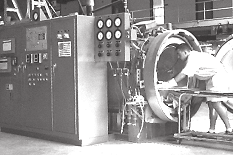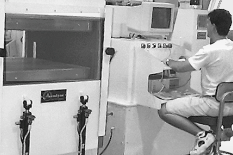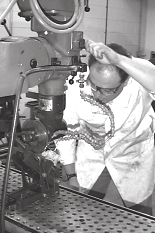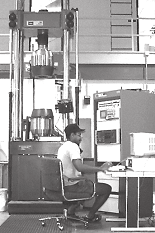![]() CORE Facilities and Equipment :
CORE Facilities and Equipment :
The Composites Research Laboratory is comprised of facilities which allow the full spectrum of specimen manufacture, preparation, inspection, and testing. The manufacture of composite components and specimens can be done in either an autoclave or a vacuum hot press.
Manufacturing Capabilities
Layup Facility
A layup facility allows the fabrication of flat laminates with arbitrary stacking sequences. This facility includes the necessary templates to accurately cut preimpregnated tape, and two four-section cure assemblies with caul plates and aluminum dams. This facility has been used to manufacture thin laminates, thick (0.5 inches) composite sections, open and closed section shell beams, and tapered laminates.
Filament Winder
Additional manufacturing capabilities include a filament winder. The filament winder is mechanically controlled and has two axes of freedom, the spindle and the carriage. Simple constant cross section geometries can be fabricated with the winder. The winder is capable of making components one foot in diameter and up to five feet long.
Autoclave
 Composite specimens and components are manufactured with the aid of a microprocessor-controlled Baron autoclave. The autoclave is capable of maintaining and controlling temperatures up to a maximum of 750 F and pressures up to a maximum of 250 psi and has a test section of 3-feet in diameter and 4-feet in length. Pressure ports allow the application of total or partial vacuums to six different cure assemblies. The autoclave capabilities allow for a range of materials to be used including thermoplastics.
Composite specimens and components are manufactured with the aid of a microprocessor-controlled Baron autoclave. The autoclave is capable of maintaining and controlling temperatures up to a maximum of 750 F and pressures up to a maximum of 250 psi and has a test section of 3-feet in diameter and 4-feet in length. Pressure ports allow the application of total or partial vacuums to six different cure assemblies. The autoclave capabilities allow for a range of materials to be used including thermoplastics.
Vacuum Hot Press
 Alternately, specimens and components can be made with the vacuum hot press. The press has the capacity of 200 tons over a 33 platen. This is equivalent to 300 psi if the full platen area is used. The press can operate up to 1000 F and is fully programmable. The vacuum hot press represents a more economical cure cycle is more capable then the autoclave. Moreover, the cycle is programmable and thus can be quickly altered during the cure cycle.
Alternately, specimens and components can be made with the vacuum hot press. The press has the capacity of 200 tons over a 33 platen. This is equivalent to 300 psi if the full platen area is used. The press can operate up to 1000 F and is fully programmable. The vacuum hot press represents a more economical cure cycle is more capable then the autoclave. Moreover, the cycle is programmable and thus can be quickly altered during the cure cycle.
Milling Machine
 The cured composite can then be fabricated with the aid of a specially-equipped milling machine. A standard Bridgeport milling machine with automatic feed in the longitudinal direction was adapted for composite manufacturing by placing an aluminum subtable on top of the milling table. This allows cutting of composite parts with diamond-grit tooling and water irrigation. The milling machine is equipped with a horizontal adapter so that both vertical and horizontal spindles are available. Numerical readouts in all three directions aid the user in fabrication. Diamond-grit circular saws, drills, and reamers are available.
The cured composite can then be fabricated with the aid of a specially-equipped milling machine. A standard Bridgeport milling machine with automatic feed in the longitudinal direction was adapted for composite manufacturing by placing an aluminum subtable on top of the milling table. This allows cutting of composite parts with diamond-grit tooling and water irrigation. The milling machine is equipped with a horizontal adapter so that both vertical and horizontal spindles are available. Numerical readouts in all three directions aid the user in fabrication. Diamond-grit circular saws, drills, and reamers are available.
Inspection Capabilities
Stereoscopic Microscope
Inspection capabilities within the laboratory include optic and radiography. A stereoscopic microscope within the Aerospace Laboratories has been additionally outfitted with eyepieces, a light source, and a camera adapter to allow for visual inspection and photographic recording of composite components to a maximum magnification is 340x.
X-ray Machine
The laboratory has an X-ray machine to nondestructively inspect composite specimens. The X-ray machine has adjustable power ratings to allow for the proper exposure of different materials and is capable of penetrating up to six inches of aluminum. The machine is also equipped with a fluoroscope and a manipulator to allow for real time inspection. The X-ray machine is helpful in determining location and amounts of damage.
Precision Scale
An inspection capability, in the form of a precision scale, also exists in the laboratory. A Mettler scale capable of 209 grams total load and a resolution of 0.0001 grams allows for the precise weight measurement of specimens. Such information is necessary in determining volume fractions, water absorption, and material loss.
Coordinate Measuring Machine (CMM)
The laboratory also has a 3-axis Numerex Coordinate Measuring Machine (CMM) capable of measuring a 24x28x16 in cube to an accuracy of 0.0003 in volumetrically. The CMM is composed of a base machine with a granite surface plate. A software package QC5000 along with many combinations of probes allow the dimensional verification of complex parts.
Testing Capabilities
Uniaxial Testing Machine
 The testing facility of the Composites Research Laboratory is centered around an MTS 810 series uniaxial testing machine. It is the largest universal load frame on the College Park Campus. The testing frame is capable of 220,000 pounds of load in tension or in compression under static and cyclic conditions. The testing machine is equipped with hydraulic grips for proper load introduction, which is especially important for composite materials. The grip area is 4-wide, 2-thick, and 6-deep, and the maximum grip pressure is 5000 psi. The machine is capable of an 8 stroke which allows for extensive buckling and postbuckling testing. Self-aligning compression platens are available capable of carrying the full load of the testing machine. A digital controller and a computer interface with 16 channels of analog to digital conversion is used for modern data acquisition. Software has been developed to allow for different computer-controlled tests, data acquisition, data reduction, and graphical output.
The testing facility of the Composites Research Laboratory is centered around an MTS 810 series uniaxial testing machine. It is the largest universal load frame on the College Park Campus. The testing frame is capable of 220,000 pounds of load in tension or in compression under static and cyclic conditions. The testing machine is equipped with hydraulic grips for proper load introduction, which is especially important for composite materials. The grip area is 4-wide, 2-thick, and 6-deep, and the maximum grip pressure is 5000 psi. The machine is capable of an 8 stroke which allows for extensive buckling and postbuckling testing. Self-aligning compression platens are available capable of carrying the full load of the testing machine. A digital controller and a computer interface with 16 channels of analog to digital conversion is used for modern data acquisition. Software has been developed to allow for different computer-controlled tests, data acquisition, data reduction, and graphical output.
Annular Furnace
An annular furnace allows exposure of specimens to temperatures of up to 2100 F while under load.
Conditioning Chamber
The laboratory also has a conditioning chamber that allows the exposure of composite specimens under controlled heat, ambient plus 5 F to 300 F, and relative humidity, ambient to 95%.
Other Facilities/Equipment
Other facilities that exist at the University, such as a scanning electron microscope, continuous ultrasonic scanning, and thermal analysis equipment may be accessed and scheduled through the laboratory.
Also see: CORE Capabilities
